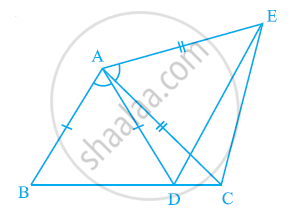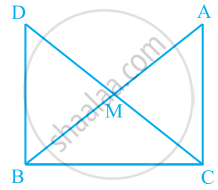Advertisements
Advertisements
प्रश्न
The perpendicular bisectors of the sides of a triangle ABC meet at I.
Prove that: IA = IB = IC.
उत्तर
Given: A ΔABC in which AD is the perpendicular bisector of BC
BE is the perpendicular bisector of CA
CF is the perpendicular bisector of AB
AD, BE and CF meet at I

WE need to prove that
IA = IB= IC
Proof:
In ΔBID and ΔCID
BD = DC ...[ Given ]
∠BDI = ∠CDI = 90°...[ AD is the perpendicular bisector of BC]
DI = DI ...[ Common ]
∴ By the Side-Angle-Side criterion of congruence,
Δ BID ≅ Δ CID
The corresponding parts of the congruent triangles are congruent.
∴ IB = IC ...[ c.p.c.t ]
Similarly, in Δ CIE and Δ AIE
CE = AE ...[ Given ]
∠CEI = ∠AEI = 90° ...[ AD is the perpendicular bisector of BC ]
IE = IE ...[ Common ]
∴ By Side-Angel-Side Criterion of congruence,
ΔCIE ≅ ΔAIE
The corresponding parts of the congruent triangles are congruent.
∴ IC = IA ...[ c.p.c.t ]
Thus, IA = IB = IC
APPEARS IN
संबंधित प्रश्न
In the given figure, AC = AE, AB = AD and ∠BAD = ∠EAC. Show that BC = DE.

In right triangle ABC, right angled at C, M is the mid-point of hypotenuse AB. C is joined to M and produced to a point D such that DM = CM. Point D is joined to point B (see the given figure). Show that:
- ΔAMC ≅ ΔBMD
- ∠DBC is a right angle.
- ΔDBC ≅ ΔACB
- CM = `1/2` AB

In ΔABC, ∠A = 30°, ∠B = 40° and ∠C = 110°
In ΔPQR, ∠P = 30°, ∠Q = 40° and ∠R = 110°
A student says that ΔABC ≅ ΔPQR by AAA congruence criterion. Is he justified? Why or why not?
In two triangles ABC and DEF, it is given that ∠A = ∠D, ∠B = ∠E and ∠C =∠F. Are the two triangles necessarily congruent?
In triangles ABC and CDE, if AC = CE, BC = CD, ∠A = 60°, ∠C = 30° and ∠D = 90°. Are two triangles congruent?
D, E, F are the mid-point of the sides BC, CA and AB respectively of ΔABC. Then ΔDEF is congruent to triangle
In a triangle ABC, D is mid-point of BC; AD is produced up to E so that DE = AD. Prove that:
AB is parallel to EC.
From the given diagram, in which ABCD is a parallelogram, ABL is a line segment and E is mid-point of BC.
Prove that: AB = BL.
In quadrilateral ABCD, AD = BC and BD = CA.
Prove that:
(i) ∠ADB = ∠BCA
(ii) ∠DAB = ∠CBA
In ΔABC, AB = AC and the bisectors of angles B and C intersect at point O.
Prove that : (i) BO = CO
(ii) AO bisects angle BAC.
